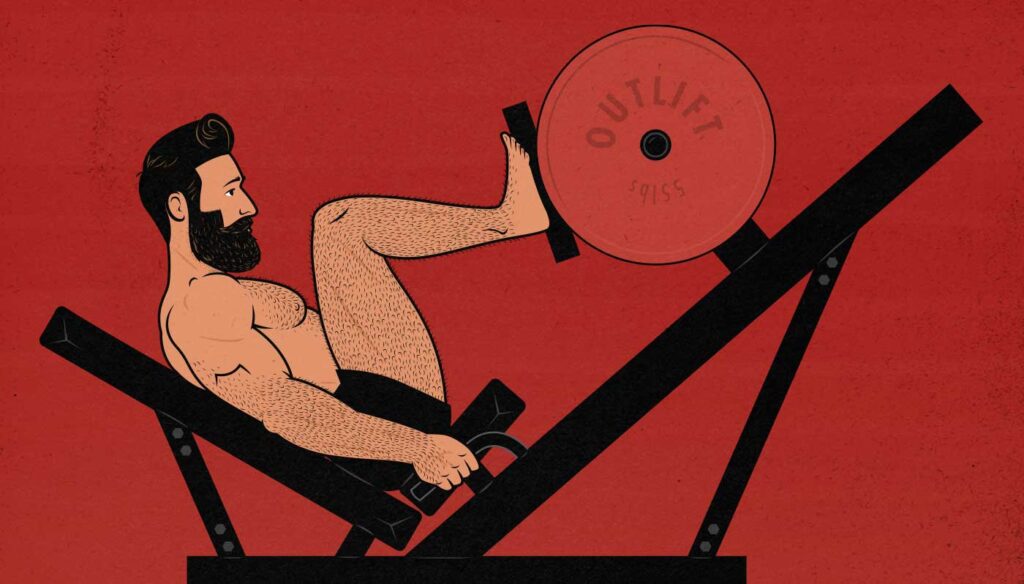
Exercise Machines Vs Free Weights for Gaining Muscle Size
Are exercise machines as good as free weights for stimulating muscle growth? It’s often said that free weights engage more overall mass, do a better job of activating our muscles, and give us more general strength. Is that true? And if so, does that mean we should avoid exercise machines?
On the other hand, machines are often thought to do a great job of isolating certain muscles, many of them are designed to have an ideal strength curve for stimulating muscle growth, and some machine lifts, such as the leg extension, can’t be mimicked with free weights. Is it true that there are advantages to exercise machines, and if so, does that mean that we should use them instead of free weights, at least on certain lifts?
Finally, the big compound free-weight lifts can be hard to learn, especially for beginners. Should a beginner start with the barbell back squat, bench press, chin-up, and barbell row, or should they start with easier exercise machine variations, such as the leg press, chest press, lat pulldown, and cable row?
In this article, we’ll cover the pros and cons of using exercise machines for gaining muscle size, how they compare to free weights at stimulating muscle growth, and if/when you should use them.
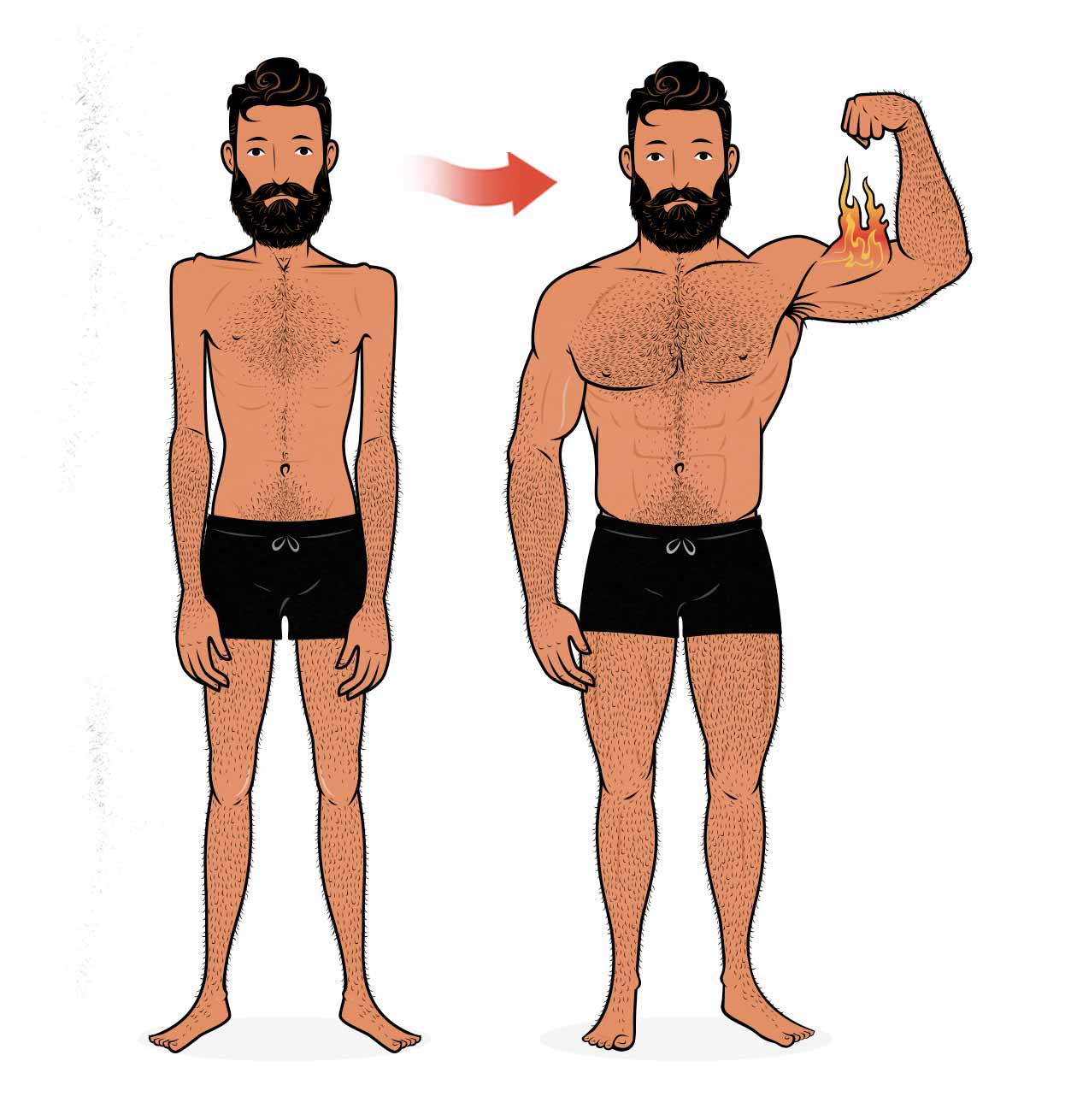
Introduction
Before we dive deep into the pros and cons of free weights and exercise machines, let’s quickly cover what they are:
- Free weights, such as barbells, dumbbells, and kettlebells, allow us to move through a “free” range of motion. The path isn’t fixed. When we press a dumbbell over our heads, we don’t just need to press it upwards, we also need to stop it from falling off to the sides.
- Exercise machines, such as the Smith Machine, chest press machine, and leg press machine, have us lifting the weight through a fixed path. We don’t need to worry about the weight falling away to the side, we just need to push against the machine.
At first glance, this might make it seem like free weights engage more stabilizer muscles and more closely mimic the lifting that we do in our day-to-day lives, making them a more efficient and natural way to build muscle. Machines, on the other hand, might seem like a better way to isolate our prime movers without needing to worry about balance or coordination. In many cases, that’s true. But not always.
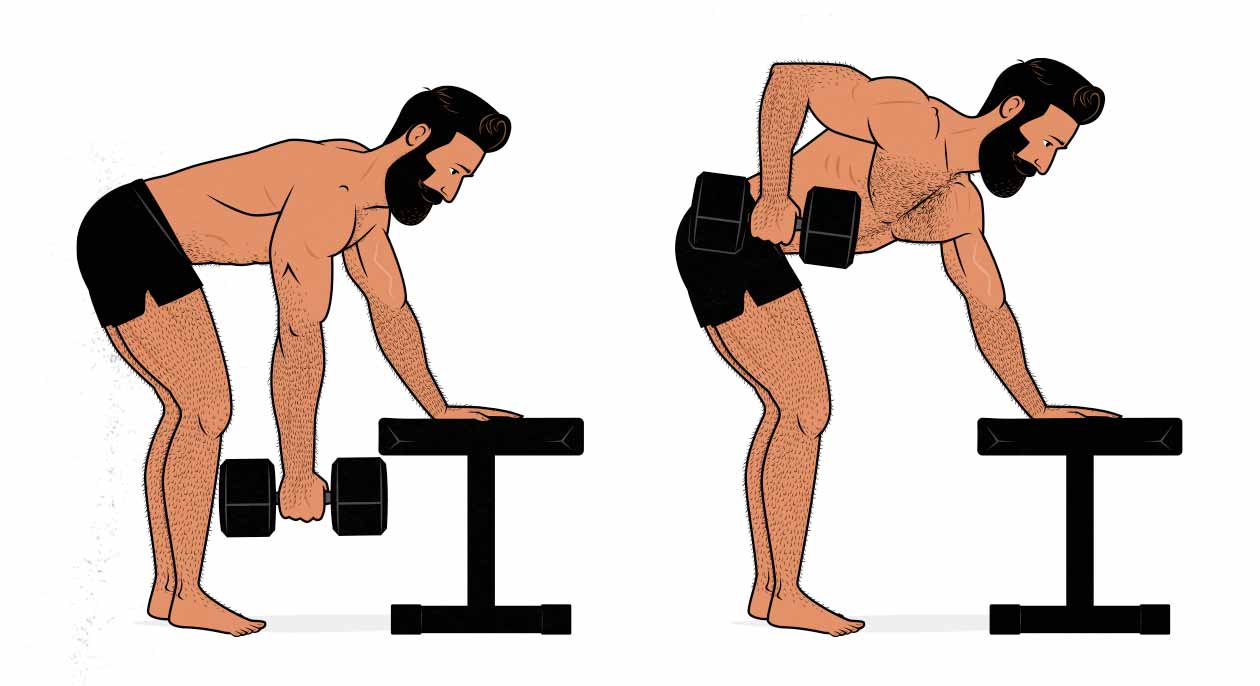
For instance, consider a typical 3-point dumbbell row, where we’re supporting our torso with our two legs and a hand. It’s a free-weight lift, but since our torsos are supported, we’ve taken the load off of our hips and spinal erectors, reducing the involvement of our stabilizer muscles. By removing those muscles from the lift, we’re engaging less overall muscle mass, but we’re also making the exercise simpler to perform. All we need to do is pull the dumbbell up. This free-weight exercise, then, has quite a lot in common with an exercise machine. And that’s not necessarily a bad thing. Maybe our lower backs are already tired from our deadlifts and squats, and so we’re trying to find a row variation that doesn’t fatigue our lower backs.
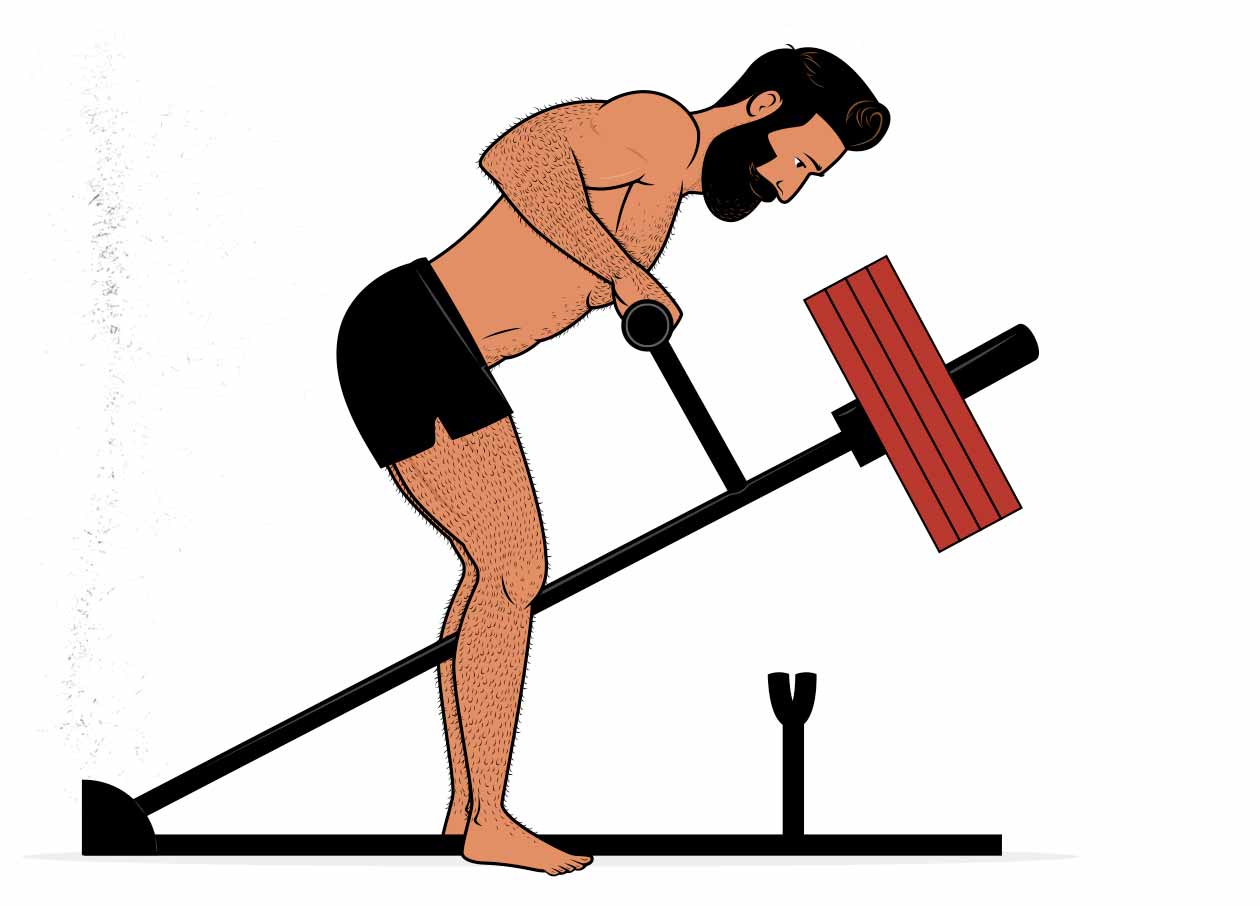
If we compare that against a t-bar row machine where our chests aren’t supported, as shown above, we get a much more compound lift. It engages our hamstrings, glutes, and spinal erectors, all of which may get enough stimulus to grow. Those particular stabilizer muscles are important for our general strength, making it a great all-around lift for gaining muscle size and strength. Now, that doesn’t mean that it’s a better exercise, just a bigger exercise.
Plus, not all machines are similar to one another. Cable machines are quite similar to dumbbells in many ways, allowing us to move through a free range of motion, and so they do just as good of a job at activating our stabilizer muscles. Seated cable rows are one of the best lifts for building up our lats, overall upper backs, and spinal erectors, easily rivalling barbell and dumbbell rows. Smith machines try to mimic the barbell lifts but force us to use a fixed par path, which, in the case of the row, is a problem, since rows don’t have a straight bar path. Other machines are made for a single specific lift, and are carefully designed to have a bar path and strength curve that’s ideal for building muscle. The t-bar row machine actually has a better strength curve than a regular barbell row.
But for the most part, when people think of free weights, they’re thinking of big lifts like the squat, bench press, deadlift, overhead press. When they think of exercise machines, they’re thinking of the leg press, Smith machine, and pec deck. And in those cases, it makes more sense to think that free weights engage more overall muscle mass, whereas exercise-machines do a better job of isolating the prime movers.
Where this gets interesting, though, is when we compare similar movement patterns done with free weights versus machines. What if we compare a barbell back squat versus a Smith machine back squat? Or a barbell bench press against a Smith machine bench press? Which will stimulate more muscle growth? Let’s look at the research.
The Research on Exercise Machines vs Free Weights
If we look at EMG research, we see that muscle activation tends to be higher with free weights than with exercise machines. For example, a study by Schick et al found that the barbell bench press was better at activating our shoulders than the Smith Machine bench press. In another study, overall muscle activation was 43% higher with the barbell squat than the Smith machine squat. So, insofar as muscle activation is related to muscle growth, that gives the advantage to free weights.
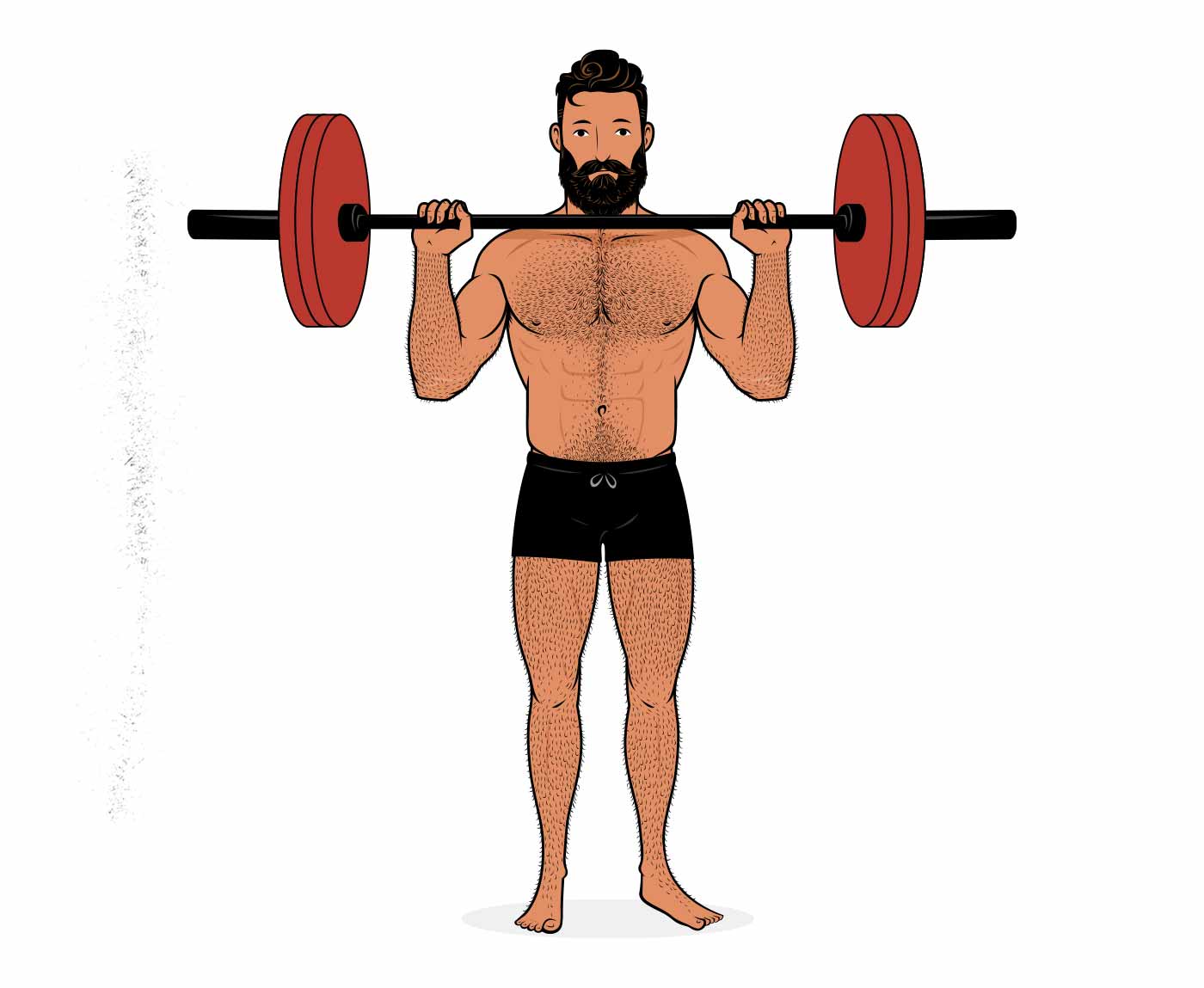
The problem is, EMG research is just a proxy for muscle stimulation. It doesn’t always correspond with muscle growth (study, study). We don’t actually know how much muscle growth is being stimulated until we measure muscle growth directly. Fortunately, a new study by Schwanbeck et al that did just that.
The participants were put on a 4-day split workout routine, training each lift twice per week, and each muscle group 2–4 times per week. The participants went through a hypertrophy phase, where they did four sets of 8–10 repetitions per set with a minute of rest between sets, and then a strength phase, with three sets of 4–5 repetitions per set and longer rest periods. That’s a reasonable way to train for muscle size and then strength. Perhaps more importantly, the free-weight exercises were similar to the machine exercises, allowing us to see the impact of using a fixed bar path.

After eight weeks, muscle growth was measured. Both groups increased the size of their quads and biceps by around 5%, with no differences between groups. So for hypertrophy of the prime movers, it looks like exercise machines and free weights are equally effective.
Now, that doesn’t tell us much about growth in our stabilizer muscles, which is where free weights are often thought to be better, but the exercise machine group gained the same amount of strength, even when strength was measured used free-weight exercises. So there may not be much difference in stabilizer muscle strength and general strength, either. Or at least not enough of a difference to be picked up by this study. On the other hand, previous research shows that training with free weights is better for improving our explosive strength and athletic performance (study).
Finally, the male participants in both groups saw a significant increase in their testosterone, showing that resistance training improves our testosterone production regardless of whether we lift free weights or use machines. However, the free weight group saw slightly greater increases in acute testosterone production than the exercise machine group. Probably not enough to matter, but perhaps a slight advantage nonetheless.
Training doesn’t have to be an either/or decision; free weights and machines can be complementary.
Brad Schoenfeld, PhD
This lines up with the advice that we get from top hypertrophy researchers, such as Brad Schoenfeld, PhD, who recommends using a mix of compound and isolation lifts, and a mix of free weights, cables, and exercise machines to maximize muscle growth.
We can build muscle comparably well with both free weights and exercise machines. There’s plenty of room for personal preference, and using a mix of different exercises is best. If we don’t like the barbell bench press, we can use a machine. If we don’t like exercise machines, we can use a barbell. Or dumbbells, kettlebells, or cables. The important thing is that we find movements that allow us to properly challenge our muscles.
Exercise Machines & General Strength
One of the big criticisms of exercise machines is that they might not be as good for developing general strength, and there’s some good logic behind that argument. But is it true in practice?
If we compare the barbell bench press against the machine chest press, in both cases we’re emphasizing our chests, shoulders, and, to a lesser extent, our triceps. Even with a barbell bench press, it’s rare for us to be limited by, say, the strength of our abs or spinal erectors. If that aspect of the lift is removed with the machine bench press, it’s not necessarily a big deal.
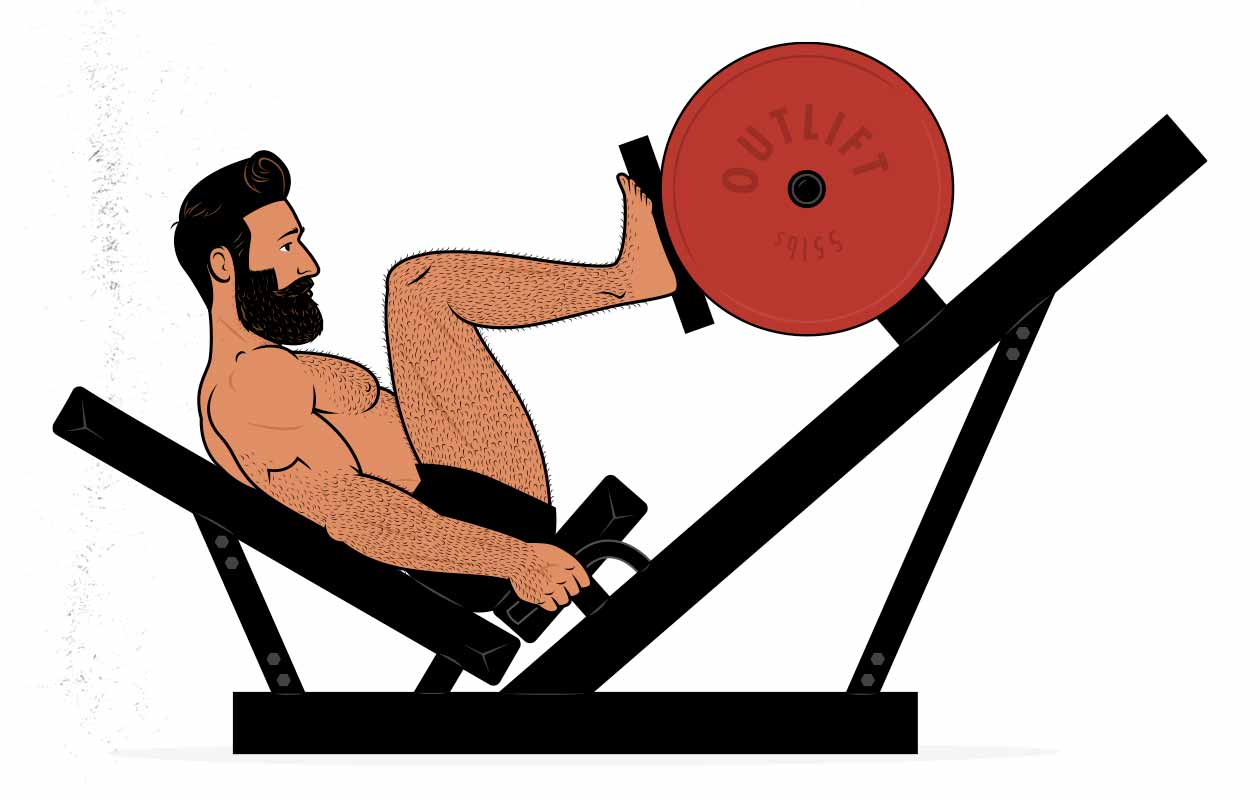
But if we swap out a front squat for a leg press, or a barbell row for a chest-supported row, we’re removing our lower backs from the equation, and so our lower backs won’t be getting enough stimulus to grow bigger and stronger. We may not develop the strength needed to lift free weights or to carry things in the real world. That’s where machines can be less well-suited for developing general strength. Mind you, that isn’t necessarily a problem that comes from using exercise machines, but rather from choosing more isolated lifts. For instance, a hack squat machine involves our spinal erectors, so that problem disappears.
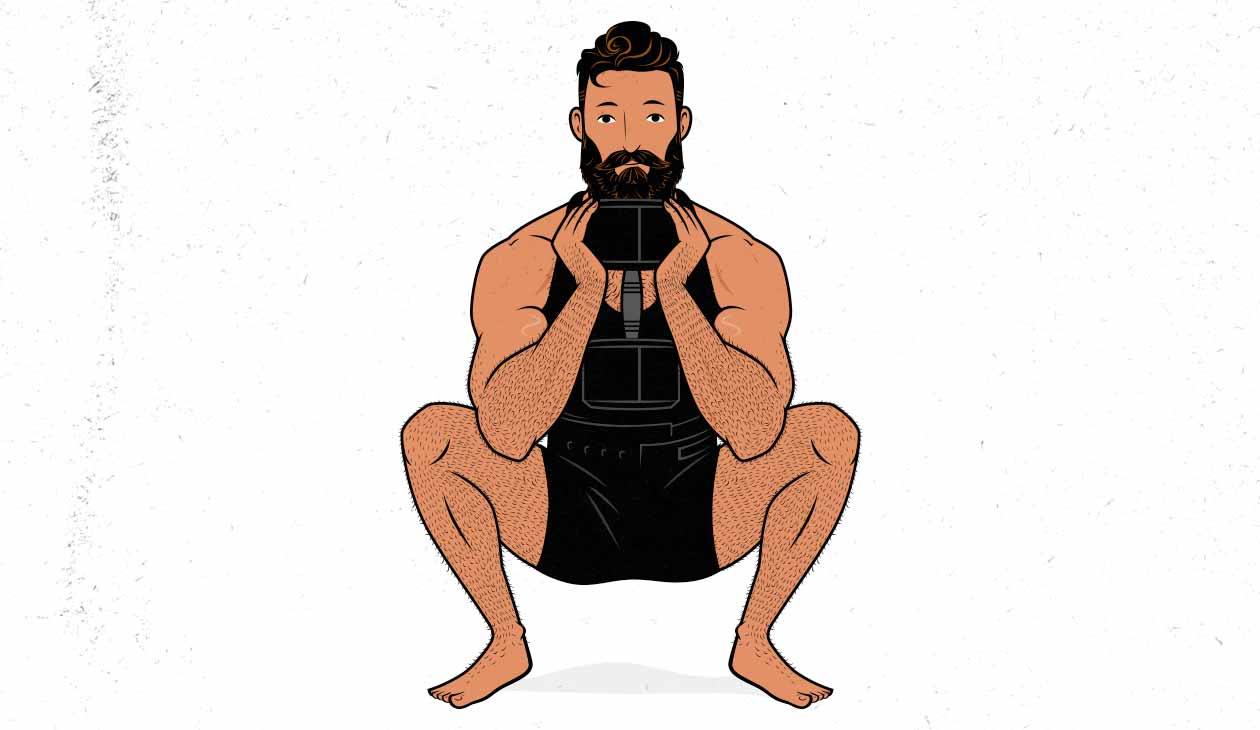
Exercise machines are good at developing strength in the muscles that are being worked, but different lifts work different muscles, and so it’s possible to choose exercises, whether with exercise machines or free weights, that don’t develop well-rounded strength. For instance, the leg press works our legs without working our backs, which might not translate very well to being able to carrying things around in our arms, especially when compared against a lift like the goblet squat.
Are Some Exercise Machines Better Than Free Weights?
So, we have good reason to believe that exercise machines can be just as good as free weights, but even so, the dynamics of some lifts make them better than others. As a general rule of thumb, we want to choose lifts that work our muscles through a large range of motion, challenge our muscles under stretch, and that are limited by the strength of the muscles we’re trying to build. That’s why deep squats are so good for the quads, the bench press is so good for the chest, deadlifts are so good for our hips and hamstrings, biceps curls are so good for our biceps, and skull crushers are so good for our triceps.

It’s not that every lift is equally good at stimulating muscle growth, it’s just that whether we do our lifts with exercise machines or free weights may be a fairly minor factor, if it even matters at all. So the question becomes, which exercise machines are best? And are there some exercise machines that offer advantages over free weights?
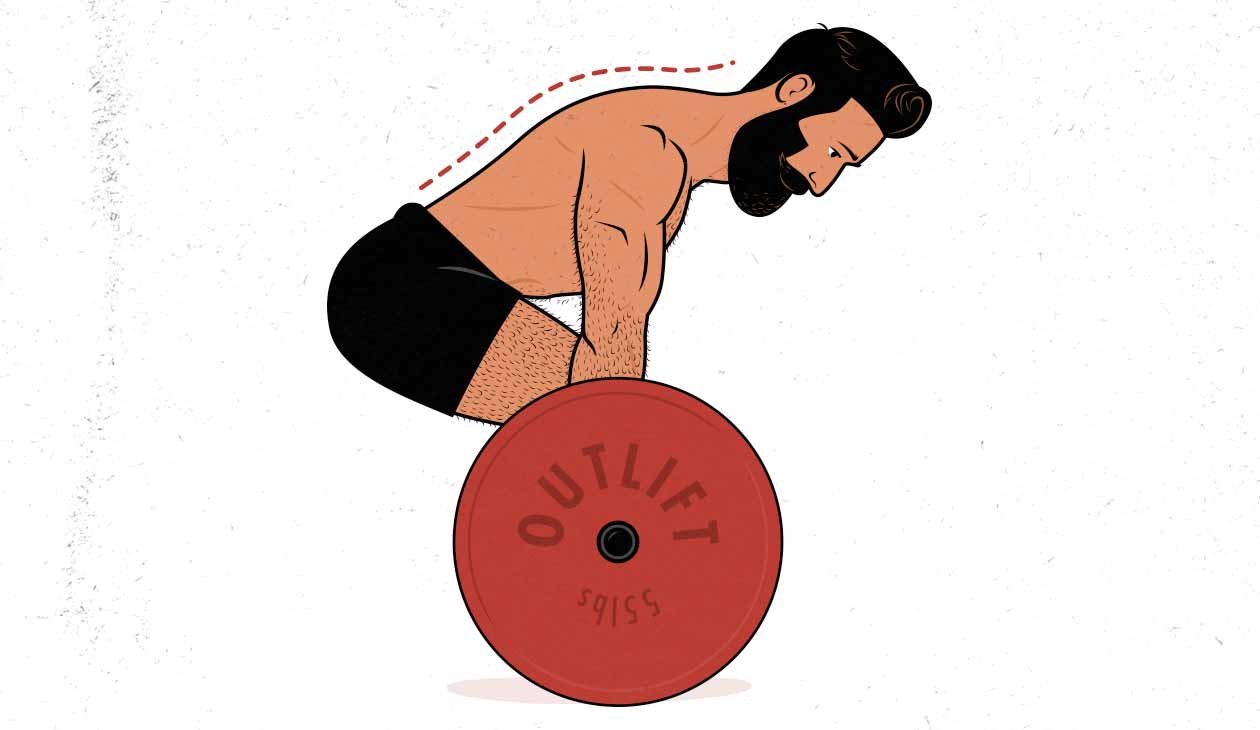
The short answer is yes. Some exercise machines do things that free weights can’t. For instance, when trying to train our hamstrings, it’s a good idea to train both hip extension (such as deadlifts) and knee flexion (such as leg curls). Leg curls are difficult to do with free weights, which is where the hamstring curl exercise machine shines. It does something that can’t easily be done with free weights. The seated hamstring curl machine also trains our hamstrings in a maximally stretched position (by stretching them at the hips), making them fantastic for stimulating muscle growth (study).
Another way that exercise machines can be better than free weights is by removing muscles that we aren’t trying to work, allowing us to focus more of our attention on the prime movers. For example, consider the leg press, which trains our quads through a large range of motion, challenges them at long muscle lengths, and isn’t limited by the strength of our backs. This makes the leg press a great assistance exercise for the squat, allowing us to accumulate higher training volumes on our quads without tiring out our lower backs.
The same is true when comparing the barbell row against the chest-supported t-bar row. The barbell row is the bigger compound exercise, but the t-bar row machine allows us to focus on building a bigger upper back without fatiguing our lower backs.
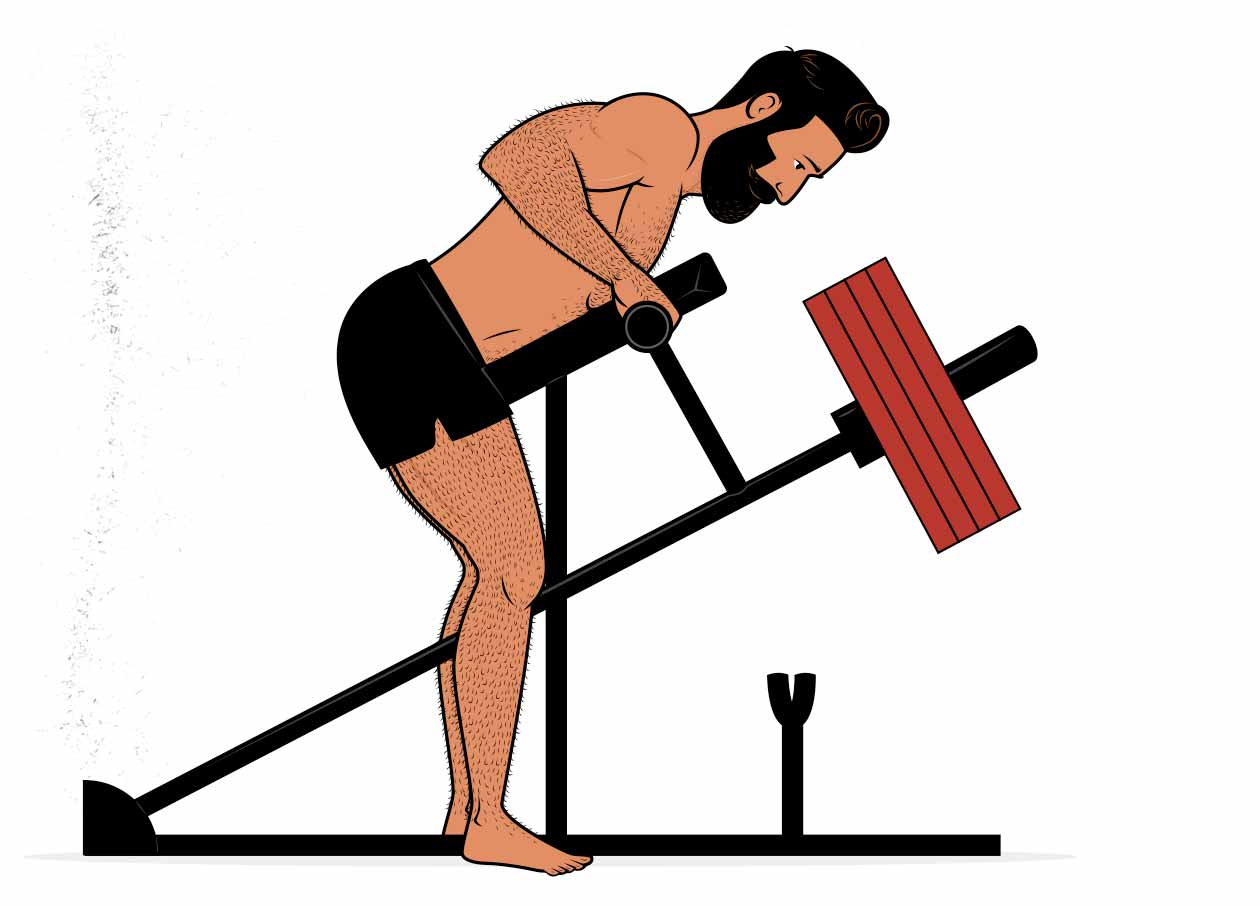
Finally, we have exercise machines that have a better strength curve than some free-weight lifts, either putting more load on our muscles in a stretched position or keeping more constant tension on our muscles throughout the entire range of motion. The t-bar row machine is a good example of this, too. At the bottom of the lift, the weight is fully supported by our hands, and so it challenges our lats in a stretched position, where they’re stronger. Then, as we pull the weight up, the weight is supported more by the fulcrum, making the weight lighter as our lats get weaker. This gives it a better strength curve than the barbell row, potentially allowing it to stimulate more muscle growth in our upper backs.
Some exercise machines have advantages over free weights, either by doing things that free weights cannot do (such as leg curls and extensions) or by doing them with a better strength curve (such as t-bar rows). As a result, if you have access to exercise machines, they might make a good addition to your bulking routine.
How to Combine Free Weights & Machines
The message of this article so far is that both free weights and exercise machines can be similarly good at stimulating muscle growth if we choose good lifts, good machines, and design our programs intelligently. In fact, if we have access to both free weights and machines, we can gain some advantages by mixing the two together. The next question, then, is how do we do that? What does a smart combination of free weights and exercise machines look like?
We recommend that most people build their hypertrophy routine on top of a strong foundation of big compound free-weight lifts. Of the big barbell lifts, five of them rise to the top, giving us a foundation that looks like this:
In most of our programs, we have people doing a few sets of each of those lifts each week. Each of those lifts trains multiple muscle groups at once and will bulk up virtually every stabilizer muscle in our bodies.
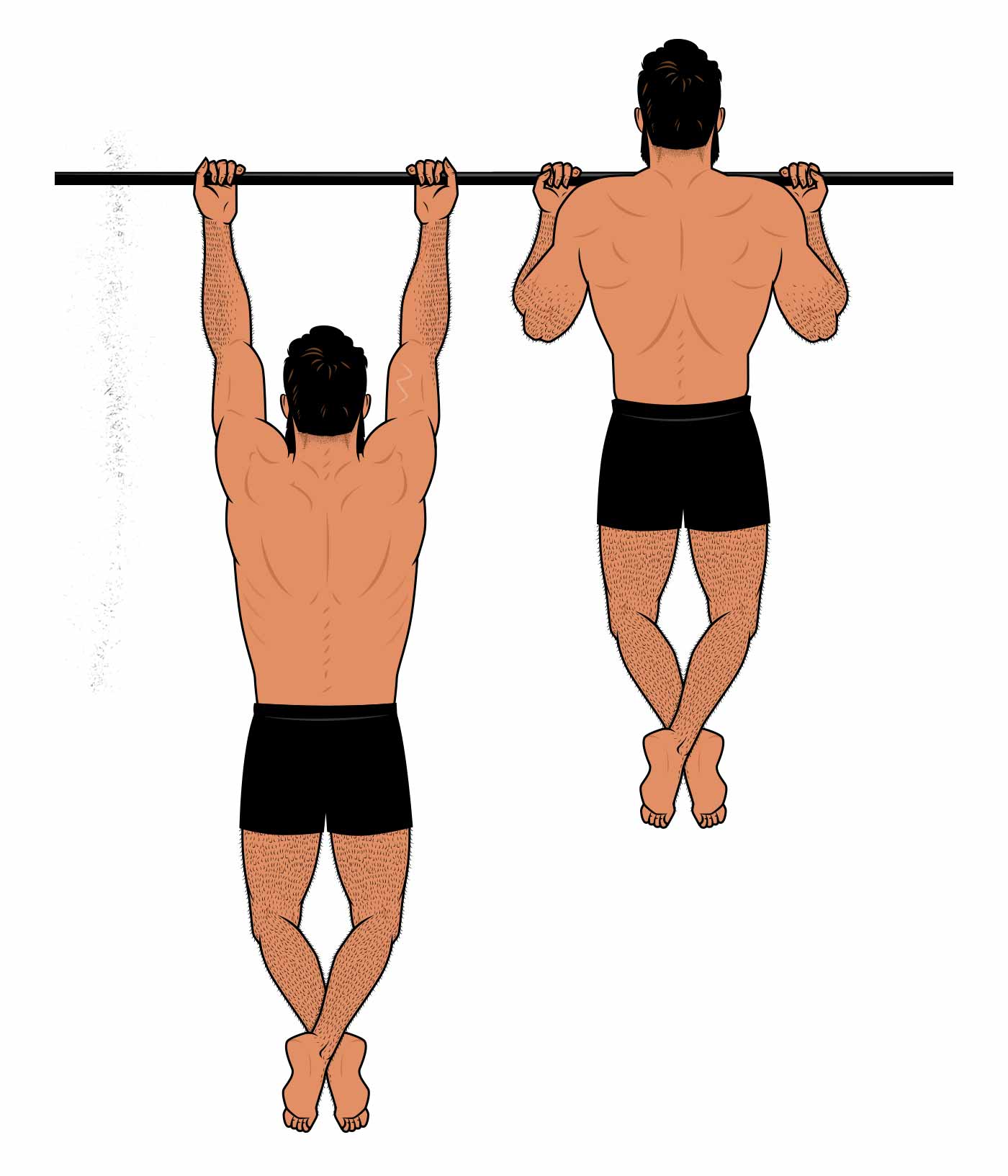
Now, keep in mind that these aren’t specific lifts, just general movement patterns. Some people might prefer back squats to front squats, or maybe they’re starting by learning the goblet squat. Or maybe they prefer using the hack squat machine. That’s okay, too. But regardless of which variation they’re doing, there’s a squat in their routine, and they do it at least once per week.
Once that’s done, we build on top of that foundation with assistance lifts. In the case of the squat, that might mean adding in a barbell Zercher squat if someone wants a bigger back, a leg press if they want bigger legs, or maybe something else entirely. Which they choose depends on their goals.
After that, they might want a smaller accessory lift to bring up a muscle that isn’t being worked properly by compound movements. In the case of the squat, the rectus femoris (a head of the quads) isn’t worked well by either squats or leg presses, and so something like a leg extension makes for a good addition.
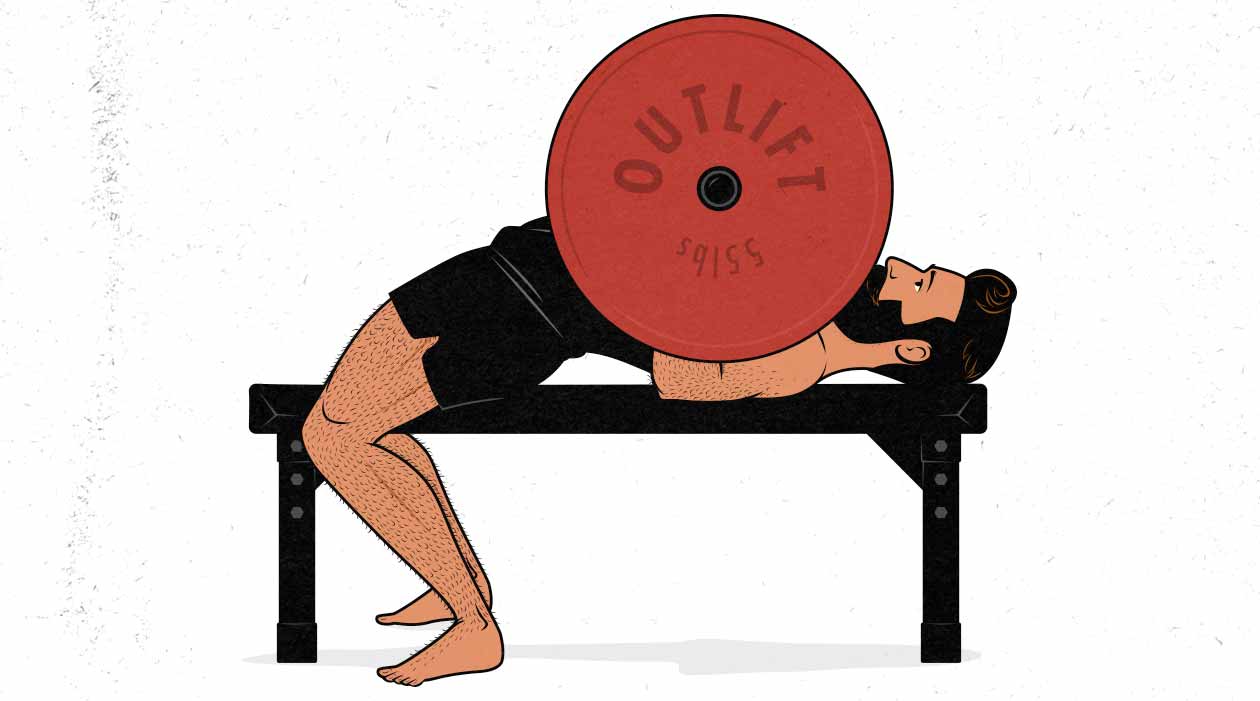
If we look at the bench press, we might have someone choosing the barbell or dumbbell bench press as their main lift, the machine press as an assistance lift, and then a skull crusher as an accessory lift, since the triceps aren’t worked very well with pressing movements. Or, if they want to emphasize chest growth, maybe they choose a dumbbell or machine fly.
Point being, once a strong foundation is in place, we have a lot of flexibility with how we build our routines on top of it. We can use barbells, dumbbells, cables, machines, or our own bodyweight. Even with the main lifts you’re doing, if you really prefer doing your squats or bench press in a Smith machine, or if you need to do your chin-ups using an assisted pull-up machine, that’s fine. You can still build muscle with machines, and at a similar speed to if you were using free weights. (Note that we generally recommend against using resistance bands unless that’s all you have access to, given that their strength curve isn’t very good.)
Or, if all you have is a simple barbell home gym, you can do everything with a barbell. There’s no real disadvantage to that. Again, the main thing is choosing good lifts and following a good hypertrophy program.
We generally recommend doing big compound lifts with free weights and then using a wide variety of exercises in addition to those main lifts. Those supplementary exercises can be done with whatever tools you prefer, ranging from barbells to dumbbells to cables to exercise machines.
The Best Exercise Machines for Gaining Muscle Size
First of all, it’s important to pick lifts that suit your body and your goals. If a given lift hurts your joints, that’s reason enough to either change your technique or experiment with a different lift altogether, even if that means moving from free weights to an exercise machine, or vice versa. Even so, some lifts are better than others, at least for most people, and so it can help to know which exercise machines are best to add into a hypertrophy routine.
- The best exercise machines for the chest: dedicated chest press machines can be quite good for working the chest under a deep stretch, often allowing for a greater range of motion than the barbell bench press. Then, for an isolation lift, both the pec deck and pec fly machines are great for challenging our chests in a maximally stretched position, and both have great strength curves.
- The best exercise machines for the upper back: the t-bar row exercise machines are fantastic, offering a better strength curve for our lats than barbell rows. The only downside is that they won’t bulk up our spinal erectors and hips, as the barbell row does. Lat pulldowns are great, too, and are quite similar to chin-ups, except working fewer muscles and putting more emphasis on the lats. For isolation lifts, straight-arm lat pulldowns are great for working the lats with a good strength curve. (And if you don’t have access to exercise machines, here are some free-weight alternatives to the lat pulldown.)
- The best exercise machines for the shoulders: shoulder press machines can be good for working our front and side delts through a large range of motion, and cable lateral raises can offer a better strength curve than dumbbell lateral raises.
- The best exercise machines for the triceps: cable overhead extensions are great at working our triceps in a stretched position, and cable pushdowns are quite easy on our elbows.
- The best exercise machines for the biceps: cable hammer curls are quite good for our brachialis muscles (which sit underneath our biceps), and bayesian cable curls are quite good for our biceps. Some biceps curl machines are good, too, but the strength curve can vary quite a bit between them. Ideally you’d find a machine that has you failing at the bottom of the curl (while your biceps are stretched), not the top (when your biceps are contracted).
- The best exercise machines for the quads: the leg press and hack squat are both great compound lifts, especially if they allow you to use a deeper range of motion. However, one of the four heads of our quads (the rectus femoris) can’t fully engage when there’s movement at the hips. Machine leg extensions, then, are a great isolation lift for the quads.
- The best exercise machines for the hamstrings: the leg curl machine is brilliant for working knee flexion, which is very hard to do with free weights, making them a great addition to a bodybuilding routine.
- The best exercise machines for the abs: cable crunches are an easy way to progressively overload our ab muscles, and they allow us to work our abs through a fairly deep range of motion.
- The best exercise machines for the calves: seated calf raises are okay, but we can train our calves under an even greater stretch by doing standing calf raises in a Smith Machine, with our toes raised up on a platform or weight plates.
- The best exercise machines for improving the deadlift: hyper-extensions, reverse hyper-extensions, and glute-ham raises are great for improving lower-back and hip strength, making them great accessory lifts for the deadlift.
There are quite a few exercise machines that can be great for building muscle. Plus, a few of them give us benefits that we can’t easily get from free weights. Leg extensions are great for building balanced quads, leg curls are ideal for building balanced hamstrings, and t-bar rows are brilliant for building a bigger upper back. Then, from a strength perspective, many powerlifters swear by reverse hypers and glute-ham raises. None of those lifts are essential, but when you have access to them, they can be worth doing, even if you have a preference for barbells and dumbbells overall.
Should Beginners Use Exercise Machines or Free Weights?
Another common question is whether it’s better for beginners to start with exercise machines or free weights. There are two arguments that you’ll often hear:
- Beginners should start with exercise machines because they’re easier to learn, safer, and allow us to stimulate muscle growth more easily. As we get more advanced, their coordination will improve, and they’ll be able to transition to free weights.
- Beginners should start with free weights to develop strength in their stabilizer muscles and engage more overall muscle mass, allowing us to build muscle more quickly. As we gain more experience, we can add exercise machines into our routines, often as assistance and isolation lifts.
Neither approach is wrong, but it’s worth pointing out that if you choose smaller exercise machine lifts, such as doing leg extensions instead of squats, then you’ll be neglecting a number of important muscles, such as your abs, obliques, spinal erectors, and glutes. As a result, when you transition over to free weights, you’ll be limited by the strength of those lagging muscle groups, and your squats and deadlift will fail to stimulate much muscle growth in your prime movers.
Mind you, that isn’t a problem of choosing exercise machines over free weights, it’s just a problem of trying to isolate specific muscles at the expense of training general movement patterns. If someone wanted to start with exercise machines, they could solve that problem by choosing the hack squat machine instead of just doing leg extensions.
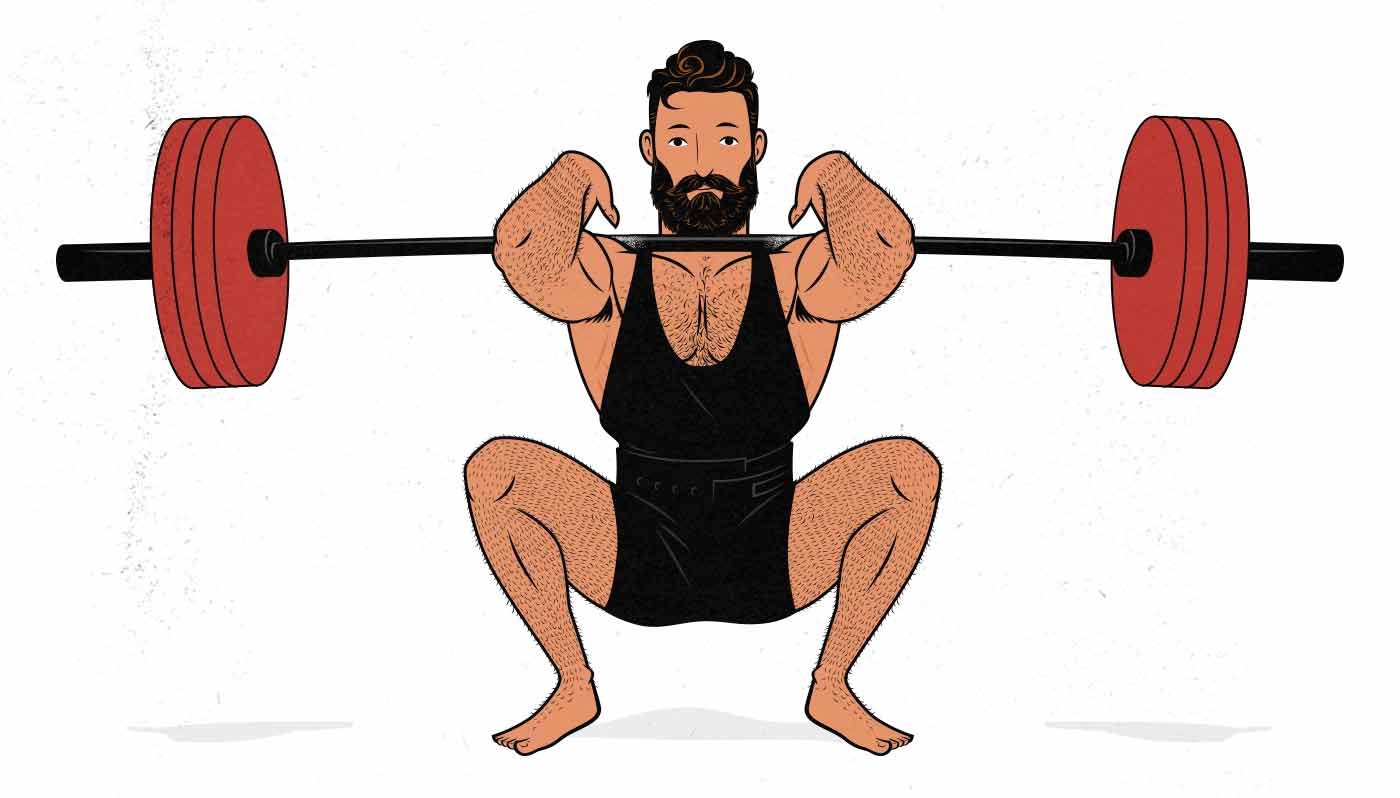
However, we’re creating a big of a false dichotomy, here. Yes, it can be hard to start with advanced barbell lifts, such as the barbell front squat or back squat. In fact, it can take a few weeks to learn the technique well enough to stimulate consistent muscle growth. It’s much easier to use the leg press machine. All you need to do is push.
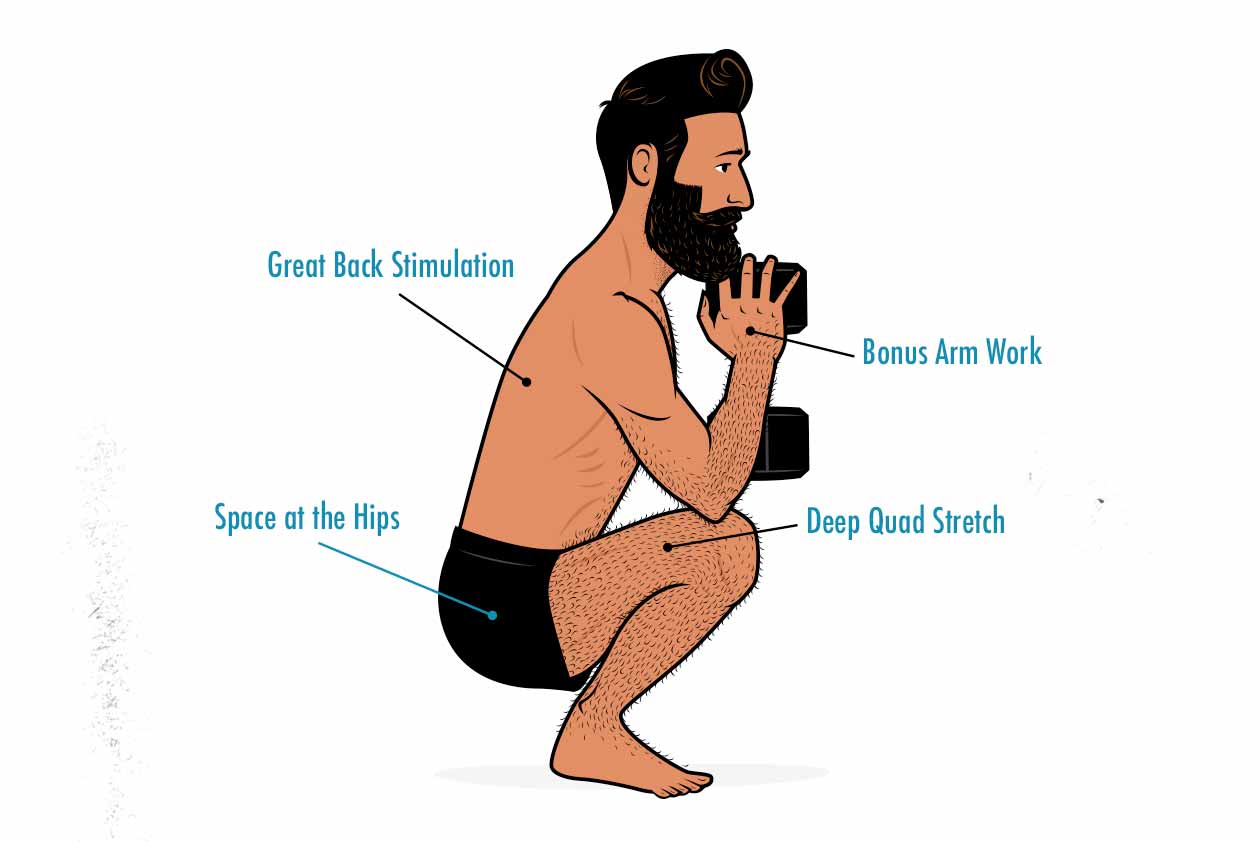
But there are free-weight exercises that are much easier for a beginner to learn, and that still allow us to support the weight with our torsos. If we look at the goblet squat, we have a simple brute strength lift that’s easy for a beginner to learn, easy to set up, and easy to stimulate a maximal amount of muscle growth with. By choosing beginner variations of the big compound lifts, we can get the benefits of all worlds.
The most important thing for a beginner to do is to start lifting weights. Whether we start with exercise machines or free weights doesn’t matter that much. It’s true that the big barbell lifts can be hard to learn, and it’s true that the easy exercise machines aren’t great for engaging much overall muscle mass, but we don’t need to be limited to those two choices. Oftentimes, the best approach is to use beginner variations of the big compound lifts, preferably with free weights, but it’s not a big deal if you want to spend your first few weeks using just exercise machines. You can still build a ton of muscle that way.
Summary
There’s a longstanding belief that free weights stimulate more muscle growth than machines, but that may not be the case. Recent research shows that both machines and free weights allow us to gain a similar amount of muscle size and strength from our training, at least in our prime movers. This means that both free weights and exercise machines can be useful tools when training for muscle size and strength.

Perhaps a more important factor is which lifts we choose. The hack squat, smith machine front squat, and barbell front squat are quite similar to one another, given how similar the movement patterns are. The leg press, on the other hand, is a whole different beast, since it doesn’t involve supporting the weight with our torsos. And then the leg extension is more different still, since it isolates just the quads. Different lifts and machines train different movement patterns, have different dynamics, and can vary quite a lot in how much muscle growth they stimulate.
Finally, using a wide variety of exercises tends to be best for stimulating fast muscle growth while avoiding joint pain and other overuse injuries, and while building muscle in a balanced and aesthetic way. So the best approach is probably to consider every tool in your arsenal and then use a smart variety of lifts. If you have access to free weights, you should probably use them. If you have access to exercise machines, you should probably use those, too. Same goes with cables.

As always, if you want a customizable workout program (and full guide) that builds these principles in, check out our Outlift Intermediate Bulking Program. Or, if you’re still skinny or skinny-fat, try our Bony to Beastly (men’s) program or Bony to Bombshell (women’s) program.



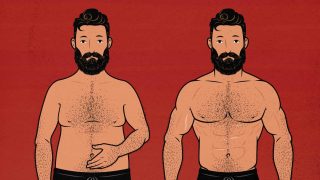
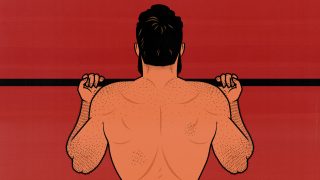
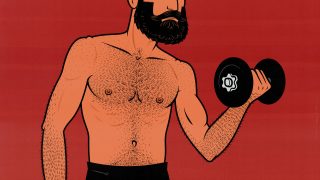

Good article Shane. Informative as always.
I agree that machine versions can build size and strength in the prime muscle groups as free weights version and eliminate the muscle groups that are not focused as far as they are trained via other lifts focusing them. For example, seated rows can be as good for lats and middle back as barbell rows as long as spinal errectors are trained via deadlift variations.
However, machine versions should be selected from “assistance lift” category instead of “accessory lift” category to rival the main free weights version. For example, selecting leg press or hack squat machine instead of leg extension.
Thank you, Farhan!
Seated cable rows can be pretty good for the spinal erectors, but yes, I agree—they won’t work the spinal erectors as hard as something like a barbell row or deadlift. With a good combination of exercises, though, not every exercise needs to do everything, and so that’s fine, yeah 🙂
I think I understand what you mean about choosing bigger exercise machine lifts if we’re trying to replace barbell lifts. Better to replace a barbell squat with a hack squat (or Smith machine squat) rather than a leg extension. But sometimes we want those smaller movements. After doing, say, front squats and leg presses, maybe a leg extension is exactly what we want, since it allows us to fully engage our rectus femoris. But again, yes, I think we’re on the same page here.
Hi Shane,
Is there a way to see the exact routine used in the study? I can only see the abstract (summary) from the link given. I’m curious because of the increase in bicep size. I’ve been gaining strength in all the 5 compound lifts, I do arm isolation lifts, but for months, I see very little if any increase in upper arm size. I’m amazed that the participants in the study increased by 5+%. I would be ecstatic to get 2% in the time they gained 5%. I have 14-14.25 inch arms, so there’s some room to grow…
Thanks!
Hey Alex, yeah, it was a 4-day split routine that alternated between two different workouts. As mentioned in the article, during the hypertrophy training phase, they did 4 sets of 6–10 repetitions for each exercise. In the free-weight group, the first workout trained the chest, back, and triceps muscles with the barbell bench press, incline barbell bench press, bent-over barbell row, chin-ups, skullcrushers, and triceps kickbacks. The second workout trained the legs, shoulders, and biceps with the squat, Romanian deadlift, lunge, calf raise, dumbbell shoulder press, dumbbell lateral raise, barbell curl, and preacher curl.
In the exercise-machine group, suitable alternatives were chosen, such as using a Smith machine for the bench press, a Hammer Strength machine for the row, and a lat pulldown machine instead of the chin-up. Very similar movement patterns, just using machines instead of free weights.
Overall muscle growth was measured with a DEXA scan and the specific muscles were measured via ultrasound. So when we’re talking about biceps growing by 5%, we’re not talking about arm circumference increasing by 5%, we’re talking about the actual biceps muscles growing by 5%. Still, yeah, those are solid gains. I’d be happy with that.
I think the secret to their biceps growth is that they were doing chin-ups, preacher curls, and barbell curls, all of which are great biceps exercises. And they were doing each of them twice per week, with 4 sets per exercise. That’s 24 dedicated sets of biceps training per week!
I got stuck for a while at around 14 inches, too. It wasn’t until I went through a few months of high-volume arm training that they finally grew. Right now, they’re a little over 15.5 inches. One tip is to make sure that you’re including some skullcrushers or overhead extensions. The long head of the triceps can add quite a bit of size to your arms, and it isn’t trained very well with pressing movements. We’ve got an article on biceps training here.
I hope that helps!
Nice, Shane, great to see a fair and balanced write-up about machines, which are often unfairly disparaged in a lot of fitness literature. I personally love the leg (ham) curl and the machine chest press (with independent moment arms). My only question is… where did your handsome cartoon man find 55 lb weights?? Is that a Canadian thing?
Heya Doc G! Yeah, leg curls are great! There was a recent study showing that they bulk up the hamstrings in a different way from hip extensions exercises, too, so they work super well when combined with deadlift variations. I’m a fan of that chest press machine that you’re talking about, too. I find I can get a really nice stretch on my pecs. Definitely one of the better machines 🙂
Competition plates often go up to 55 pounds, and those 55-pound plates are traditionally red. Here’s one sold by Rogue. The 45s are traditionally blue, which we use over on the Bony to Beastly site. They’re rare in commercial gyms but you’ll see them in powerlifting gyms, Olympic weightlifting gyms, and people like to get them for their home gyms, too. It’s my little detail to show that this Outlift guy with the beard is a bit stronger, more advanced 😉
Ah! Well thanks for clearing up that little mystery! Keep up the great work.
And yeah, it’s too bad that exercise machines are often disparaged in the online fitness community, especially when all the top experts keep trying to tell us that they can work really well. I think this may be the first high-quality study to compare actual muscle growth, though. Maybe people will start to think of machines more favourably now.
Enjoying these reviews of different programs and methodologies. We are bombarded with all sorts of claims about training styles and programs, and it’s good to hear what each camp thinks of each other.
Another good review topic would be Super-slow Training and High Intensity Training, represented by Arthur Jones, Ellington Darden, and Doug McGuff’s book Body by Science. These methods typically argue for a training style with a cadence of 10-20 seconds, 1 set to failure, and 1 training session per week. Most versions use machines, and Super-slow Training was part of the marketing for the Nautilus machines.
There are some very large claims by Super-slow and HIT, but there is a general lack of before-and-afters on the internet from people doing the method, and some of the ones that exist are misleading like the Casey Viator situation.
Most of the sources on Super-slow Training and HIT on the internet are uncritical, but here are some critical reviews:
https://muscleevo.net/super-slow-training/
https://www.t-nation.com/training/does-hit-training-get-you-into-heaven
Alex Fergus also did a 9-month experiment with HIT, but his results weren’t super impressive, and he is an advanced training who wouldn’t be expected to have a big transformation anyway.
https://www.alexfergus.com/blog/body-by-science-high-intensity-training-review-my-9-month-experiment
PD Mangan is one of the only people I’ve seen claiming to be using HIT with success, though I’m not sure if his program is the same as the above approaches: https://accordnutrition.com/one-hour-fitness-review/
Do you guys have any additional thoughts about these schools of training beyond what is already on the internet? Is there any credibility behind the claims for any type of trainee? Does the science in Body by Science really back up its conclusions, and is there conflicting science? Why aren’t there more people posting transformations with it? Could make for a good article.
Hey Rick, yeah, those’d make for cool articles. I like that idea.
We’ve written a bit about HIT in this article over on Bony to Beastly. And we have an article about training volume and frequency, too.
We haven’t written much about lifting tempo yet, but I’ve got an article planned for that 🙂
Extremely useful, as always. Thanks for putting this together!
Thank you, Mac! My pleasure 🙂
Very nice article. It’s nice to know that machine exercises can build almost the same amount of muscle that free weights can. It gives us another option when we can’t do the exercises on free weights. Thanks for the info.
One question I have Shane regarding exercises like Deadlifts and Squats, for those people with previous back or groin injuries, or a hernia. Or maybe they have difficulty maintaining good form in those exercises due to muscle coordination complications from past injuries. Can we do those exercises on a cable squat rack machine with a bar? I see people do these at one of the fitness clubs I go to. They’re not as hard as the free-weight versions of squats and deadlifts, but safer. You can do shoulder presses and bench presses with this cable rack, too. Or are we better off using the machine version you suggested in your article, leg press, hack squats, hyperextensions, reverse hyperextensions, glute-ham raises, chest press machines, and shoulder press machines?
Hey Gregory, thank you!
Deadlifts and squats are a fairly broad category. Maybe doing 5-rep sets of powerlifter-style squats and deadlifts causes problems. But maybe doing 10-rep sets of front squats or Romanian deadlifts doesn’t. So I wouldn’t just write off the exercises entirely. You might still be able to benefit from them, especially if you slowly reintroduce them into your routine.
I wouldn’t recommend trying to mimic those exercises on a Smith machine. You may run into the same issues, and I’m not sure it would be any safer. The Smith machine has a fixed bar path, and that can be a bit harder on the joints sometimes. If you’re already someone with a history of injury, I’m not sure that’s the best approach. I think it’s better to use exercise machines that are designed to suit the movement of your body. Leg presses, hack squats, hypers, and reverse hypers are great alternatives to squats and deadlifts 🙂
Glute-ham raises (and leg curls) are great for your hamstrings, too. And hip thrusts, glute bridges, and those donkey kick machines are great for your glutes. Those make for good accessory lifts 🙂
I like this article. My limitation is I have Ehlers-Danlos syndrome, so I’m prone to dislocations and subluxations (partial dislocations). Thus, I’m reliant on machines almost exclusively for weight training since my joints need the stability and support. When I have tried going heavy with free weights, I injure myself. This is a syndrome that is seldom diagnosed, even when someone suffers from dislocations and such. I wish I could use heavier free weights, though, as I agree with you Shane that a mix of those and machines would be good.